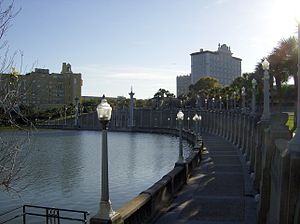 Downtown Lakeland, Florida, image via WikipediaBy Bob Andelman
Downtown Lakeland, Florida, image via WikipediaBy Bob Andelman
Maddux Business Report
March/April 2010
Fifty years in the commercial real estate business. That’s a huge milestone for Lakeland-based Hauger-Bunch Inc., to be sure, but company president David Bunch says it’s not going to be a year full of celebration.
“You want an honest answer? I don’t have a clue,” he says. “Too many things at play that no one knows what to do with. I think it’s going to be the same (as last year). I don’t see anything too drastic changing it one way or the other.”
The prolonged land, development and leasing slump—and that’s probably too mild a word, but who wants to use the “D” word?—is not unlike some other memories Bunch recalls from his five decades of sales and the 800 businesses his company sited in those years.
“We’ve been through some funny times in those years that, to me, were as painful as this is,” he says.
But—and this is the key, he says—he’s not giving up.
“I have to be positive or I couldn’t sell anything,” Bunch says. “This country is not out of business. There is pain, there is suffering, but 85 to 90 percent of the country is working—contrary to what some people seem to think. So we look for the business. Somebody is doing something somewhere and we’ll go there.”
Seniority earned Bunch the right to sound off first in the Maddux Business Report’s annual commercial real estate outlook, but his views could have come from virtually anyone we surveyed. The prognosticators are uniformly sour on the months ahead, their eyes and hopes already locked on 2011, one hand clamped on their nearly empty wallets, the other covering their erratically beating hearts.
There’s enough blame to go around, but government gets a lot of it. Disappearing jobs are a huge issue and lost jobs translate into empty office, industrial and warehouse space.
“I don’t think I’ve seen anything of this magnitude in the years I’ve been in the business,” says Robin Bishop, president of Tampa-based Robin Bishop & Associates. “There is light at the end of the tunnel but I think we’ve got another year or so of this. The statistics are pretty startling. In every class of space, in every submarket, there has been negative absorption. When you see Westshore at 20 percent vacant… Not that long ago it was five percent. The most staggering statistic is in the Westshore submarket—750,000 sf of negative absorption. I don’t think you’ll see any new buildings come out of the ground anywhere in Tampa.
“We need jobs,” she adds. “That’s dragging us down here in Florida, particularly in Tampa.”
Steve Kossoff, managing director of Meridian Development Group in Clearwater and Sarasota has seen a little more activity—busywork, you might call it—but overall, it’s the same mindset as 2009.
“Last year,” he says, “Southeast investment sales were off 78 percent compared to the year before. It was abysmal. Leasing is at a snail’s pace. Vacancies are up, rates are down. The Sarasota-Bradenton market is almost unrecognizable compared to 2006-07. There is just nothing going on. It was so reliant on tourism and never diversified into other employment; now they’re left trying to pick up the pieces. It’s very tough sledding there now. A 70-person architectural firm we dealt with is out of business. The engineering firm we use laid off half its staff. We’re just managing our legacy assets. We haven’t bought a building in two years.
“Candidly,” Kossoff concludes, “I think we’ll be talking a year from now and be seeing some tangible improvement to the market. But I think it’s going to take another year.”
No argument there, says Hogan Group CEO Mike Hogan.
“Two-thousand-and-nine, in my opinion, was horrible,” says the Lutz-based developer. “There was virtually no leasing activity. There was no development because the banks aren’t loaning money. They say they are, but there is no demand. The economy was horrible. We had four or five projects that just stopped. Pieces of property we had, including a Kohl’s Department Store, were put on hold. And for the record, ‘08 wasn’t much better than ‘ 09. We are seeing an increase in office and retail traffic. Not deals, but people walking in the door, wanting to look at space for probably the first time in three years.”
Tampa real estate attorney Ron Weaver can tick off all the ways that the commercial real estate business collapsed—although Stearns Weaver stays pretty busy as a result of the fallout. “Office continues to freefall,” he says. “It’s going to have an awful year. The 17 percent official vacancy rate is probably closer to a true 30 percent. Technically you’ve got a tenant who may be paying rent or reduced rent but it’s on available space. You can go to a company and maybe they’re using 70 percent of their space and you could ask them to sublease 30 percent and they’ll say, ‘Please!’”
One of the issues hampering commercial real estate is the real or perceived collapse of the loan market.
NorthMarq Capital Managing Director Bob Hernandez doesn’t mince his words: he thinks it’s already happened.
“People may not know it if they’ve been paying their mortgage,” he says. “But if you have a loan coming due in the next few years, you’ll see values have come down 20 to 50 percent. Even if you’re going along the same as before, bankers will apply market rates to your rolling rents and cap rates and the loan you get will be greatly reduced.”
“There is no question that the CMBS (commercial market-backed securities) market is a large pool that has to be recast,” says Raymond F. Sandelli, senior managing director for CB Richard Ellis-Tampa. “Part of that will be mitigation by the lending institutions today who will look at loans closer and look at clients with whom they choose to move forward. The key was to keep the system from collapsing, but the regulators moved in and, in their attempt to be judicious, were very hard on the lenders. People must first understand how the system works, what the rules are. Then they can look at the problems and look for the solution. Is there a concern? Yes. But people have a better sense of what the rules of engagement are. And I think the CMBS market will come back in some fashion. It’ll help mitigate the problems out there.”
That’s another reason for pessimism, says John T. McKay, president of the Riverside Real Estate Company in Bradenton.
“So many of the assets that are going to have problems have not come to a head yet,” he says. “The banks and other lenders are in a state of denial. And the banks are forced to be in a state of denial by the regulators. It’s not by choice. One minute their FDIC insurance is increased; the next minute the feds put another rule or regulation on them—contrary to everything you see about lenders being encouraged to lend more. There is a gap between the rhetoric on the political side and the actions of the regulators.”
Not to get biblical in this already overheated climate, but McKay believes there will come a reckoning in the money markets.
“As for the predicted deterioration of the commercial market, because of the reported $1.5 trillion in loans coming due over the coming years, that has yet to occur with the banks,” he says. “With the conduits— the Wall Street vehicles that made loans on shopping centers and office buildings—and the life insurance companies, it has yet to occur because the minimum loan term from the conduits was five years. Most people agree the peak was 2006-07, so those aren’t due yet. And when they are due, the conduits are faced with limited options because they have so many bondholders and the bondholders can have different objectives.
“It’s going to be interesting.”
You’ll get an “Amen!” to the notion of a coming day of financial bedlam from Bruce Erhardt.
“That’s definitely coming,” according to the executive director of Cushman and Wakefield in Tampa. “The financial institutions make the decision that says, ‘Pay me something and I’ll let you go another year or two.’ But if they lose tenants and rents go down more, they’ll probably lose the building. I don’t know how much longer we can pretend and extend; a rolling loan gathers no loss. But once it stops… that’s going to be a problem in the buildings the C class developers built. And then there are the people who just paid too much.
“There are a lot of buildings out there,” Erhardt continues, “that don’t have a prayer to get refinancing because they don’t have the income to support the currentdebt. Some might be able to pay to refinance; others won’t make it. They paid too much at the peak. But the next guy in will buy it from the bank, lease it up and sell it at a profit.”
A common refrain in this survey is that there are investors who won’t even get into the market until there is total distress; they account for much of the money reportedly sitting on the sidelines during the current crisis. Billions of dollars in real estate loans will likely roll over in the next two to three years and be dumped at huge discounts to eager buyers who smell someone else’s loss and their own profit.
There are some positive indicators in the market, of course.
Sandelli chuckles at the thought of a better year ahead. But it’s a pleasant chuckle.
“I think ‘08 was a freefall,” he says. “People felt the system was coming apart; I don’t know if there was a bottom. By mid-‘09 people started realizing the world wasn’t coming to an end and started planning for ‘10, planning the revenue. Everybody ratcheted back on expenses. Once people got to that point, they needed to downsize, renew or look for additional resources. After a quiet 12 months, we see the market starting to move and we see people once again adept at making decisions. I think it’s wrong to go back and say, ‘When’s it going to be like it was a few years ago?’ It’s not. But a few years ago didn’t make a lot of sense. Now you look for where the opportunities are and move forward.”
Raj Ravi, managing director of Prudential Commercial Real Estate in Land ’o Lakes and South Tampa, says 2010 “has to” be better ’09.
“Last year brought a learning curve on how banks and lenders handle certain properties,” he says. “But properties will have to move. Banks—per government—will have to increase capital and get properties off the books. Not to exaggerate it, but there are some deals coming up. A lot of banks will get more aggressive. And buyers will see deals and say, ‘I would have liked to have been in that,’ whether bankers or brokers are showing them opportunities. It’s not going to be a home run year, but better than ’09.”
One possible ray of light: leasing.
“Lease rates are lower but for shorter terms, so the landlord isn’t locked in,” according to Ravi. “The tenant is saying, ‘If I can get these terms, that will let us determine where things are going.’ At some point, things have to equalize. I don’t think there is any other option except to get back to what some people would call normal—at some point, but we’ve got a few years of adjustment ahead of us. What I know is, there are new and different opportunities coming up. And there are people who will capitalize on that and come out on top. We’re seeing deals, hearing about deals—we’re doing deals. When the right opportunities come up, you can see the right people coming in. There are funds and cash out there.”
The first places to see that will be in-fill locations where there is strong traffic and supportive demographics. “The recovery will be less,” Ravi says, “as you get to the outskirts and rural areas. The A locations are always going to get higher volume. We see people upgrading from B or C locations to an A or B because they know they can get in at a reduced lease rate. And as far as sales go, people are buying A properties they couldn’t buy a few years back. Now some of them are making sense at the numbers they being offered.”
Bunch feels the same way about Lakeland.
“I’m so imbued in dealing with my market here in Lakeland, sitting between Tampa and Orlando on I-4,” he says. “I think everybody see things as we do. Us being the recipient of overflow from two major markets and Disney, we’re going to be fine here. I wouldn’t change my location for anything. We’re not over-absorbed in anything. We’ve got appetite for everything. We have availability for 1.5 million sf of good, legitimate, modern warehouse space right now. And we have absorbed 1 million sf a year for many years, so that’s not a scary number. We don’t have a lot of vacant large offices; when things turn up, it’s going to be at multiple levels.”
The recovery of the commercial side of the market is dependent upon the speed of the recovery of the residential market, says McKay, who visualizes how it will occur. “Many, many subcontractors have left our state. They’ve gone to Louisiana and Texas. Once those folks start coming back, you’ll see apartments recover. Then warehouses and showroom warehouses will come back. Then I think you’ll see retail and office come back after that. Those two will lag the apartment and industrial markets.”
At Lakewood Ranch, residential sales—of both existing homes and land for new construction—is leading LWR Commercial Realty President Brian Kennelly to expect improvement on the community’s commercial side.
“It’s encouraging that our existing inventory for sale dropped below three percent,” Kennelly says. “That percent peaked at 10 percent. That has driven buyers back to our homebuilders. We closed 33 residential lot sales in the last five weeks in ‘09. Those were to builders with buyers. I’m scratching my head, too, sometimes, but that inventory is dropping. You can buy homes cheaply, but builders have adjusted to that by adjusting what they’re selling. Packages aren’t as expensive as they were. That’s how they’re getting people back in the door.
“As a result,” Kennelly adds, “I saw commercial activity pick up in the last quarter of 2009. We got some small lease deals done and there are some land transactions, which is a significant difference from the rest of last year. It doesn’t mean they’ll all get done—the primary obstacle being the capital markets.”
Weaver says business at his real estate-intensive law firm is different this year than last—better, actually.
“Deal-flow is up,” he says, “and not just the year-end stuff that had to be done for tax and other reasons. We’re seeing a distinct improvement. Industrial seemed one of the last to fall and is the first to come back. Industrial people don’t mess around. They get to the bottom of how bad it is and come back.”
Residential small lots sales are up, especially for townhome sites and more affordable lots, according to Weaver. “First-time homebuyers are using that $8,000 federal credit. Two-thousand-and-eight was denial and ‘09 was, ‘Oh, my goodness,’ with stronger expletives used by the sellers. The buyers have been scooping up better deals and they can afford their land-use lawyers again.
“Retail is begin to stabilize or not falling as fast as it was,” Weaver continues. “There are a few types of retail that can survive. And some of the banks are actually growing and buying branches in the market. Mutual of Omaha and Homebanc, Bay Cities Bank—certain banks are doing a good job. Some have gone out and reestablished certain market opportunities. Loans are being made, sometimes with the requirement of a relationship, some with 75 percent loans instead of 100 percent loans and stark appraisals.
“We have been so busy doing due diligence for buyers looking for bargains. There has been environment review all over the state, lots of due diligence related to foreclosure and related to those buying and selling notes. Due diligence is due diligence. Bad time due diligence is the same as good time due diligence. So when the market comes back you will have your regulatory requirements in place.”
Weaver credits “lots” of property use litigation statewide with keeping his staff of lawyers busy. “A lot of property owners have had time to reflect on the way government has treated them,” he says.
Sidebar: The Dirt Devil Speaks
Bill Eshenbaugh, president of the Eshenbaugh Land Co. in Tampa, spoke to the Maddux Business Report from his car in January, driving back from a statewide marketing meeting of commercial real estate brokers in Orlando. Eshenbaugh was a speaker at the event.
“I have to be pretty optimistic to face the market everyday. I told them that I don’t have any distressed real estate. I have righteously priced real estate. Look at values from 1999-2002 and I see what I work with was worth then—it’s worth the same today…
“A guy came up to me after my talk and said, ‘I have notes from what you said last year. Last year you said, “It’s going to take patience and resistance.” And it appears from what was said today, you were right. So I’m writing this ‘righteous pricing’ thing down today and will remind you of it next year.’”
Eshenbaugh pauses.
“What’s the statute of limitations on speeches?”




